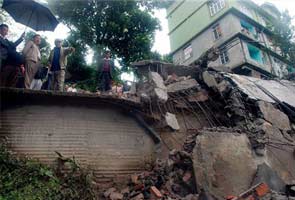Gangtok: Around 68 people have died in India, 50 of them in Sikkim, in the devastating earthquake which measured a forceful 6.8 on the Richter scale. Most of the deaths have been reported in north Sikkim.
The quake hit parts of North India at around 6 pm on Sunday and was centred on the Sikkim-Nepal border, 64 kilometres north-west of Gangtok. Casualties have also been reported from neighbouring Bihar and West Bengal.
At least 20 people have also died in Nepal and Tibet.
India's Home Secretary RK Singh has said the death toll may rise further. ''The number of deaths reported by the state government of Sikkim is 50. This may increase further as rescue and relief teams reach into the interiors. The number of deaths in West Bengal are reported to be 12 and in Bihar 6.''
Nearly 36 hours after the region's worst earthquake in 60 years, rescue operations remain the biggest challenge - rain and landslides are severely hampering the efforts; bad weather is not allowing helicopters to land, Indian Air Force planes are air-dropping food. There was a fresh landslide in Gerkhola, located 30 kms from the Sikkim border. This landslide has now been cleared.
Meanwhile, helicopters with Quick Reaction Teams have landed in Mangan, Sikkim - the epicentre of the quake. The helicopters are carrying two medical teams with doctors and paramedics. Getting to Mangan is still a challenge, though, as many roads are closed due to the bad weather. Other problems are also playing a part. There have so far been 10-12 landslides between Mangan and Filong.
A road to Mangan has been opened by the army. Approximately 200 Army troops including medical teams are now in Mangan. This is not the highway though but an alternate route that has been opened by the army
More than 6,000 Army jawans are being used to provide assistance to those affected. Around 2,000 people have taken shelter at Army camps.
Among the toughest parts of the recovery is the operation to re-open National Highway 31A which connects Sikkim to the rest of the country. It is needed to bring in food and other supplies.
There are other challenges facing the state. Sikkim's Chief Minister Pawan Chamling cannot use his office. Water and power supply remain erratic; phone towers have been hit, making communication tough. In the capital Gangtok, more than 100,000 buildings have been severely damaged. Government offices and hospitals have been left unusable.
Mamata Banerjee was scheduled to visit Gangtok today but now her trip stands cancelled. Before her visit the West Bengal Chief Minister said her priority was to ensure that National Highways 31A and 55, damaged by landslides, were repaired urgently so that food and other supplies could be transported more easily.
The quake hit parts of North India at around 6 pm on Sunday and was centred on the Sikkim-Nepal border, 64 kilometres north-west of Gangtok. Casualties have also been reported from neighbouring Bihar and West Bengal.
At least 20 people have also died in Nepal and Tibet.
India's Home Secretary RK Singh has said the death toll may rise further. ''The number of deaths reported by the state government of Sikkim is 50. This may increase further as rescue and relief teams reach into the interiors. The number of deaths in West Bengal are reported to be 12 and in Bihar 6.''
Nearly 36 hours after the region's worst earthquake in 60 years, rescue operations remain the biggest challenge - rain and landslides are severely hampering the efforts; bad weather is not allowing helicopters to land, Indian Air Force planes are air-dropping food. There was a fresh landslide in Gerkhola, located 30 kms from the Sikkim border. This landslide has now been cleared.
Meanwhile, helicopters with Quick Reaction Teams have landed in Mangan, Sikkim - the epicentre of the quake. The helicopters are carrying two medical teams with doctors and paramedics. Getting to Mangan is still a challenge, though, as many roads are closed due to the bad weather. Other problems are also playing a part. There have so far been 10-12 landslides between Mangan and Filong.
A road to Mangan has been opened by the army. Approximately 200 Army troops including medical teams are now in Mangan. This is not the highway though but an alternate route that has been opened by the army
More than 6,000 Army jawans are being used to provide assistance to those affected. Around 2,000 people have taken shelter at Army camps.
Among the toughest parts of the recovery is the operation to re-open National Highway 31A which connects Sikkim to the rest of the country. It is needed to bring in food and other supplies.
There are other challenges facing the state. Sikkim's Chief Minister Pawan Chamling cannot use his office. Water and power supply remain erratic; phone towers have been hit, making communication tough. In the capital Gangtok, more than 100,000 buildings have been severely damaged. Government offices and hospitals have been left unusable.
Mamata Banerjee was scheduled to visit Gangtok today but now her trip stands cancelled. Before her visit the West Bengal Chief Minister said her priority was to ensure that National Highways 31A and 55, damaged by landslides, were repaired urgently so that food and other supplies could be transported more easily.

 Click to Expand & Play
Click to Expand & Play
No comments:
Post a Comment